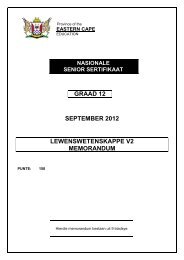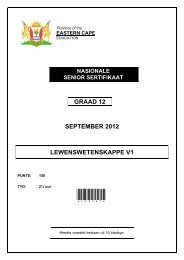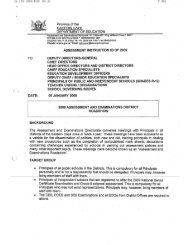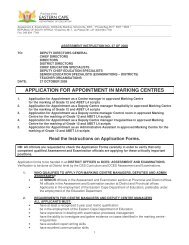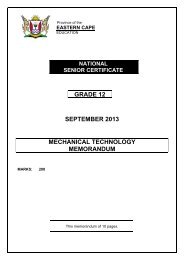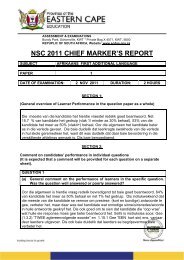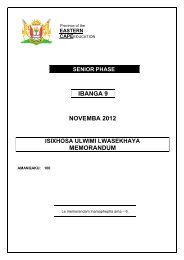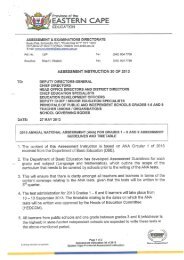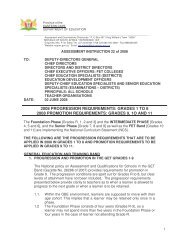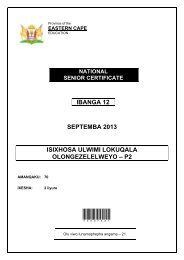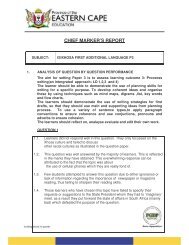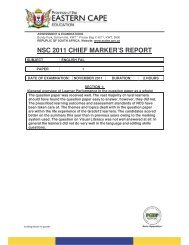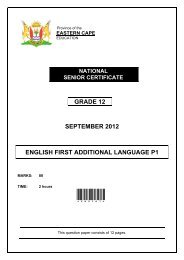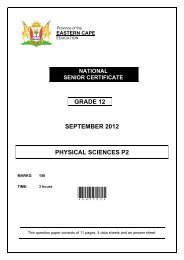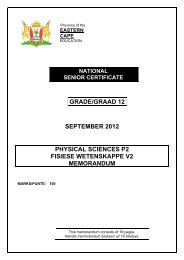Sesotho HL Paper 2 - Ecexams.co.za
Sesotho HL Paper 2 - Ecexams.co.za
Sesotho HL Paper 2 - Ecexams.co.za
Create successful ePaper yourself
Turn your PDF publications into a flip-book with our unique Google optimized e-Paper software.
QUESTION 22.1 This was a <strong>co</strong>ntextual poem which among others aimed to assess thecandidates’ knowledge of the poem type, devices used and semantics.It was a choice question from the prescribed list.2.2 This is in line with LO 2, LO3 and LO 4 and their AS’s. Performance in thisquestion was not bad in that most candidates s<strong>co</strong>red more than 5 out of 10marks.2.3 Some candidates were able to identify “lebotsi”, but instead of explaining thefunction thereof they supplied its definition – mainly that it is a rhetorrhicquestion.QUESTION 33.1 This was also a choice question from the prescribed list; it aimed to assess“mookotaba” (theme),”tlotlontswe” (vocabulary) and “makgabane abothothokisi” (poetic devices).3.2 The question was relevant as it sought candidates to apply critiquing techniqueswhich form part of LO 2, LO 3 and LO 4 and their AS’s. A mediocreperformance was registered, although it was largely passed.3.3 “Mookotaba” in 3.3 was mostly <strong>co</strong>nfused with “molaetsa” – thus causing themnot to get full marks.• Candidates explained “dinatshana” outside the <strong>co</strong>ntext of the poem – they<strong>co</strong>uld not detect that it was used metaphorically (it <strong>co</strong>ntextually referred tothe feminine gender). The question was clear and direct, but it was mostlymissed.• Some seemed not to <strong>co</strong>mprehend that “tlohelo” was invariably used to referto “kgonyetso” in the question paper – but that did not disadvantage anylearner as such.QUESTION 44.1 The last of choice poems in the prescribed list, it aimed to assess meaning ofpoetic lines, identifying devices used, explaining words.4.2 This did not deviate from the requirements of the NCS in that the above havereference in LO 2, LO 3 and LO 4 and their AS’s. This was a popular choiceand performance was good in this poem. A few 10 out of 10 were noted.4.3 Quite a few candidates failed to <strong>co</strong>mprehend that “dishweshwe” and “dipalesa”actually referred to the feminine gender (like “dinatshana” in question 3).
QUESTION 88.1 This question was a <strong>co</strong>ntextual <strong>co</strong>unterpart to question 7 – same novel. Itaimed to assess the literature critiquing skill in a <strong>co</strong>ntextual form.8.2 This was a relevant question for NCS – LO 2 (fully) and LO 3(partly) wereengaged. This was a more popular choice than its essay <strong>co</strong>unterpart; evencandidate performance attested to the question’s popularity. Excellentperformance ranged between 23 to 25 marks, the latter being the total mark.8.3 However, some missed a few subquestions, such as 8.7, which requiredcandidates to state the time (era) of the events in the novel. Normally this refersto the time in relation to the milieu, not in relation to chronometer (watch) timeor a particular point in time during the day. Most of those who missed thissubquestion referred to all the other instances of time than the era of the eventsin the novel. All in all,QUESTION 99.1 This was an essay choice question with similar aims with question 7 – <strong>co</strong>nflictbeing the main thrust, set from Seema’s Diepollo, a novel.9.2 Refer to question 7. The least popular choice that was badly performed by thosecandidates who wrote it.9.3 See question 7.QUESTION 1010.1 Seema’s novel, Diepollo, was set as a <strong>co</strong>ntextual choice and <strong>co</strong>unterpart ofquestion 9. The question aimed to assess the literature critiquing skills in<strong>co</strong>ntextual form.10.2 LO 2 – 4 together with all the AS’s were assessed in line with NCS. It wasalso not chosen by many, but most of those who chose it performed well.10.3 As in Question 8, those candidates failing to s<strong>co</strong>re high marks were put off byabout two subquestions, namely 10.7 which required information not availablein the extract, thus proving that they may not have done the whole book, and10.10 –which required them to state the beginning of <strong>co</strong>nflict in the novel.
QUESTION 1111.1 This question was an essay type set on Mme, a prescribed novel by NPMaake. Its main thrust was to assess the skill of <strong>co</strong>nflict: beginning,development and climax.11.2 It <strong>co</strong>vered LO2, LO 3 and LO 4 in languages and was therefore relevant. Thiswas the most popular choice – seemingly it is done by most schools.Performance was very excellent.11.3 Whilst performance was excellent, the essay writing tenets – introduction,body and <strong>co</strong>nclusion, still needed attention, thus scaling down the marks ofthose who lack these skills. More <strong>co</strong>mments similar to these refer in question7.QUESTION 1212.1 This was a <strong>co</strong>ntextual <strong>co</strong>unterpart of question 11, aiming at assessingliterature critiquing skills in a <strong>co</strong>ntextual form.12.2 This was a relevant question in terms of the NCS requirements. This was alsoa popular choice to those who were averse to the essay type. Performancewas very good in this question.12.3 There were quite a few cases of 25 out of 25 marks, with near perfect casesof 23 and 24 marks. However, there were minor problems in responses suchas where candidates <strong>co</strong>nfused characters in the novel and dramatis personaein the drama genre.QUESTION 1313.1 This was an essay type of question which sought to assess the literary critiquingskills including milieu and <strong>co</strong>nflict. Seyalemoya, a <strong>co</strong>llection of 6 one-act plays byR Moeketsi, was the main source of the assessment instrument. This was also thefirst question on the drama genre.13.2 This was relevant in that it <strong>co</strong>vered LO 1 – LO 4. This was not a popular choice –perhaps it is not done (chosen) by most schools (centres). Performance wasmediocre to bad.13.3 Whilst some candidates were able to give factual evidence with regard to thisquestion, a key problem was that of <strong>co</strong>nfusing characters and story lines. Thisdisturbed an otherwise mediocre attainment. For instance, the character, Tholang,in Sekgobo sa Tshifanalehata was invariably <strong>co</strong>nfused with Kgasiane from Ha seboya ba ntja.
QUESTION 1414.1 This was the <strong>co</strong>ntextual <strong>co</strong>unterpart of question 13 – same book, sameeditor/author. The literary critiquing skills in general were assessed.14.2 This was a relevant question that was NCS-<strong>co</strong>mpliant. Performance matched thatof other <strong>co</strong>ntextual questions in other <strong>co</strong>ntextuals, although even here problems of<strong>co</strong>nfusing characters was evident.14.3 Performance here was much better than in its essay <strong>co</strong>unterpart.QUESTION 1515.1 Haeso Mafotholeng by CJ Teleki, was the source of assessment in question 15.An essay-type of question was set to assess milieu and <strong>co</strong>nflict; it was identical tothe other drama book in question 13.15.2 This was a relevant question <strong>co</strong>vering LO 2 – LO 4. Since this is a <strong>co</strong>ntinuousstory, and not a <strong>co</strong>llection of stories, performance was <strong>co</strong>mmendable. It was amuch more popular choice than its one-act plays <strong>co</strong>unterpart.15.3 Deficient essay writing skills spoiled an otherwise excellent output. See <strong>co</strong>mmentsin question 7 with regard to the type of problems noticed.QUESTION 1616.1 Same book, same author as in question 15, the only difference being thatassessment here was <strong>co</strong>ntextual – assessing critiquing skills in general.16.2 An appropriate question in line with the NCS programme. Performance hereexceeded that of its question 14 <strong>co</strong>unterpart, attesting to the fact that the bookenjoys more acceptance that the other drama book.16.3 Comments on further attainment problems <strong>co</strong>mpare fairly well with those inquestion 8 and 12 above.
2. ANY ADVICE THAT YOU COULD GIVE TO EDUCATORS TO HELPLEARNERS TO REACH THE EXPECTED LEVELS7.1 For structural critiquing, educators would do well to first identify devices theywould like to teach, after which they group poems with such devices togetherwithout teaching the themes of the individual poems – the <strong>co</strong>ntent of the poemscan be done as a se<strong>co</strong>nd round of dealing with them. This can go a long waytowards teaching learners to differentiate between the themes and <strong>co</strong>ntent fromthe literary devices.7.2 The “drill method” can still be functional as a means of drawing a line ofdifference with regard to literary devices that seem to be similar though not.7.3 Learners need training in writing appropriate essays in literature (and indeed allessays), embodying the basic tenets thereof – introduction, body and<strong>co</strong>nclusion.7.4 Both the denotative and <strong>co</strong>nnotative meanings of words, phrases, lines andstan<strong>za</strong>s should be taught alongside of one another – to clearly differentiatebetween the two levels of meaning.3. ANY OTHER COMMENTS• It would benefit educators – and in turn the learners – if they <strong>co</strong>uld arrangecluster seminars early in the year to address <strong>co</strong>ntent gaps leading to a <strong>co</strong>mmonunderstanding of literature, using the prescribed works as resources. In suchseminars, the more proficient educators, under the baton of subject advisors,<strong>co</strong>uld assist others in dealing with aspects such as “tlhekelo,sesosa sakgohlano, kgodiso ya kgohlano, sehlohlolo, mothipoloho” and others as theyapply to the prescribed works.• The markers agreed that this was a balanced paper which tried to embody all the<strong>co</strong>gnitive levels of assessment – including a fair spread of learning out <strong>co</strong>mes ofreading and writing.• The examiners used accessible language throughout, even attaching synonymsin some cases.



